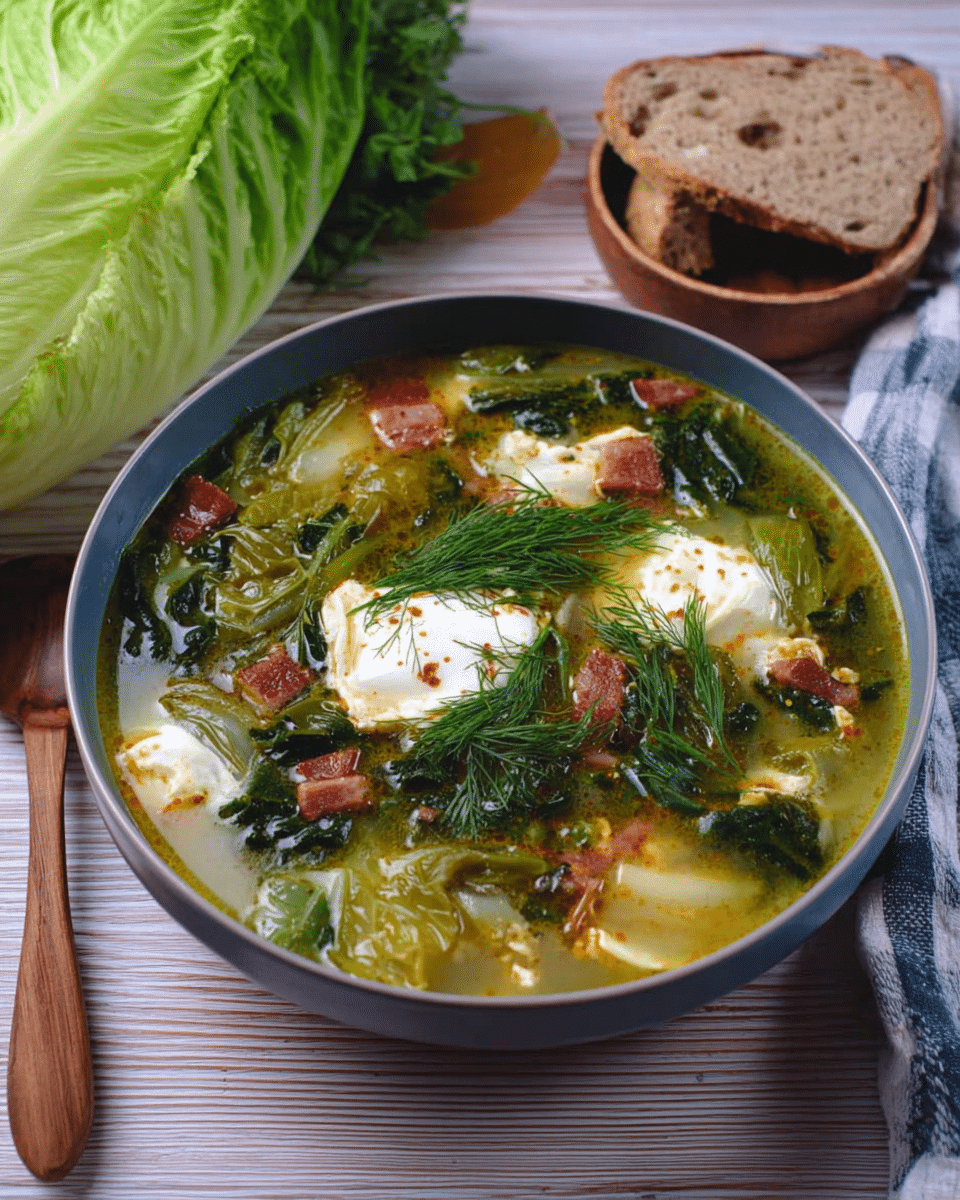The romaine lettuce soup, inspired by traditional Transylvanian cuisine, is a delightfully unique recipe that transforms humble greens into a savory, comforting dish. With layers of flavor built from a paprika-infused roux, crispy smoked bacon, fresh dill, and tender omelette strips, each spoonful brings warmth and richness.
This soup is especially popular in spring and early summer when fresh greens are abundant. It’s a simple yet unforgettable way to use up extra lettuce, perfect served with sour cream and a slice of crusty bread. Whether served hot or chilled, it’s a hearty nod to heritage cooking with everyday ingredients.
Full Recipe:
Ingredients:
-
2 large romaine lettuce heads (or 4 small)
-
4 large free-range eggs
-
200g smoked bacon or pancetta, chopped
-
3 cloves garlic, minced
-
1 bunch fresh dill, chopped
-
50ml sunflower oil
-
3 tbsp wheat flour
-
1 tbsp Hungarian sweet paprika
-
2L water
-
2 tbsp white sugar
-
50ml white vinegar (or lemon juice)
-
2 tbsp sea salt (divided)
-
1 tsp dried vegetable soup mix
-
Freshly ground black pepper to taste
Directions:
-
Wash romaine lettuce leaves thoroughly and cut into bite-sized pieces.
-
In a large soup pot, heat the sunflower oil over medium heat. Add the flour and stir continuously until it turns golden.
-
Mix in sweet paprika, immediately followed by a splash of water to prevent burning. Cook for 1 minute.
-
Add chopped lettuce and mix gently to wilt slightly.
-
Pour in 2 liters of water. Add minced garlic, 1 tablespoon salt, sugar, half the dill, and vinegar. Stir well and let simmer uncovered for 20 minutes.
-
Meanwhile, in a frying pan, cook the bacon until golden and slightly crispy.
-
Beat the eggs in a bowl, season with salt and pepper, and pour over the bacon. Cook until set, creating a rustic omelette.
-
Cut the omelette into bite-sized strips and add to the simmering soup along with the remaining dill.
-
Season with remaining salt and vegetable soup mix. Let simmer for another 2 minutes and serve.
Prep Time: 10 minutes | Cooking Time: 25 minutes | Total Time: 35 minutes
Kcal: 158 kcal | Servings: 6 portions
Transylvanian Romaine Lettuce Soup – A Taste of Tradition, Simplicity, and Soul
When people think of soup, romaine lettuce doesn’t usually come to mind. It’s more often tossed in a Caesar salad or tucked into a sandwich. Yet in Transylvania a region of deep valleys, rolling green hills, and rich culinary tradition romaine (or other garden lettuces) is the star of a humble, comforting dish: romaine lettuce soup, often enriched with fried bacon and soft egg ribbons. This soup isn’t just a meal it’s a heartfelt expression of peasant ingenuity, seasonal cooking, and the resourceful elegance that defines traditional Eastern European kitchens.
A Glimpse into Transylvanian Cuisine
Transylvania, known globally for its dramatic landscapes and folklore, is also home to a diverse and rustic culinary heritage. Influenced by Hungarian, Romanian, Saxon, and even Ottoman traditions, the food of this region emphasizes affordability, seasonality, and full-bodied flavors. Lettuce soup locally referred to as saláta leves or ciorbă de salată is a dish that was born out of necessity. It comes from a time when resourcefulness in the kitchen was not a trend, but a way of life.
Fresh produce was a luxury in winter, so spring and summer recipes made the most of what the garden offered. Lettuce, especially romaine and butterhead varieties, grew abundantly and needed to be used quickly. Unlike the firm heads of iceberg, romaine’s leafy, slightly bitter profile lends itself beautifully to wilting and simmering.
In this soup, it’s not just about the lettuce. The supporting cast of ingredients smoked bacon, eggs, vinegar, dill, and a simple roux turn something that might seem too delicate into a robust, satisfying meal. The dish stands as a shining example of how simple ingredients can be transformed into something deeply comforting and nutritionally complete.
The Heart of the Soup More Than Just Greens
What sets this soup apart from other vegetable-based broths is its layered complexity, despite its simplicity. The foundation is a roux flour fried in oil until golden and nutty. Paprika is added to deepen the color and enhance the aroma. Water and chopped romaine follow, and it’s here where magic happens.
Simmering softens the lettuce without turning it into mush. Unlike spinach or kale, which can dominate a dish, romaine mellows in the broth, its subtle bitterness balanced by the sweet paprika and a touch of sugar. Garlic and vinegar either white or wine based introduce brightness, while dill provides herbal depth.
But the pièce de résistance? The omelette. In Transylvanian fashion, crispy bacon is fried until golden, then eggs are cracked in and gently cooked to form a rustic scramble or flat omelette. This is then sliced or broken into pieces and stirred into the soup. These hearty additions introduce protein, texture, and a satisfying richness. Each spoonful becomes a small mosaic: delicate leaves, rich egg strands, and smoky morsels of bacon floating in a tangy, aromatic broth.
The Cultural Role of Lettuce Soup
This dish isn’t just a recipe it’s a ritual in many Transylvanian and Hungarian households. It’s especially common in early spring, often eaten after the first harvest of lettuce or as a light but satisfying lunch on warm days. It’s versatile enough to be served warm, room temperature, or even chilled depending on the weather and the cook’s mood.
Because it includes no expensive ingredients and can be adapted endlessly, lettuce soup is also associated with frugality and wisdom in the kitchen. It reflects a generation who cooked not from Pinterest or YouTube, but from memory, garden, and intuition. In rural villages, grandmothers might prepare it after gathering lettuce from the backyard, teaching children not just how to cook but how to live with gratitude and efficiency.
How It’s Traditionally Served
Romaine lettuce soup is most often served with a dollop of sour cream or a side of polenta, especially in Romanian traditions. The sour cream offers creaminess and tang, complementing the vinegar in the broth. Polenta adds texture and makes the meal more filling true peasant food, hearty and nourishing.
In more Hungarian-inspired versions, bread is usually the preferred accompaniment. A slice of crusty white bread or a soft roll helps soak up the rich broth and eggy ribbons.
And of course, in many households, a bit of hot chili or pickled pepper might be placed on the side for those who enjoy a bit of fire with their soup.
Modern Variations and Customizations
While the classic version is treasured, many cooks enjoy putting their own twist on romaine lettuce soup. Some substitute pancetta for bacon or use smoked tofu for a vegetarian version. Others include sliced green onions or even leeks to increase the aromatic base.
The eggs, instead of being scrambled into an omelette, can be stirred directly into the hot broth for a more egg-drop texture. Some prefer to add a splash of cream or milk to make the broth smoother and silkier, turning it into more of a bisque-style soup.
And while white vinegar is traditional, apple cider vinegar or lemon juice is a fantastic substitute for a slightly fruitier brightness.
The key is balance: the soup must retain its humble character while being customizable to fit modern dietary needs or pantry limitations.
Why This Soup Still Matters
In an age of meal kits, pre-packaged foods, and global fusion dishes, this Transylvanian lettuce soup remains deeply relevant. It’s seasonal, sustainable, and budget-friendly. More importantly, it connects us to a time when food was an act of both survival and love where every part of the garden, every scrap of bacon, and every egg had value.
It also serves as a lesson in looking beyond appearance. Lettuce, often considered bland or only suitable for salads, is elevated in this dish. It challenges assumptions and reminds us that flavor can come from unlikely sources if treated with care.
For food bloggers and home cooks alike, this recipe offers an opportunity to educate, surprise, and nourish. Sharing it online helps preserve a cultural legacy that might otherwise be forgotten in today’s fast-moving food world.
Conclusion:
Transylvanian Romaine Lettuce Soup may be unfamiliar to some, but it deserves a spot on any seasonal table. With its perfect interplay of earthy greens, smoky bacon, tender eggs, and tangy broth, it tells a story of a place, a people, and a way of cooking that celebrates resilience and creativity.
It’s the kind of dish that soothes as much as it surprises. One bowl is not just a meal it’s a warm embrace from the past, gently reminding us that simple ingredients, when treated with respect, can become something extraordinary.
So next time you’re staring at a head of romaine and wondering what else you can do with it, think beyond the salad. Think Transylvania. Think soup.






